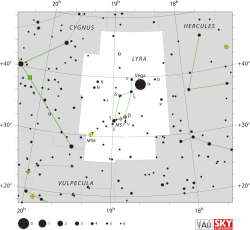Lambda Lyrae
| Lambda Lyrae (λ) | |
 | |
| Observationsdata Epok: J2000.0 | |
|---|---|
| Stjärnbild | Lyran |
| Rektascension | 19t 00m 00,82568s[1] |
| Deklination | 32° 08′ 43,8527″[1] |
| Skenbar magnitud () | 4,937[2] |
| Stjärntyp | |
| Spektraltyp | K2.5 II[3] |
| U–B | +1,609[2] |
| B–V | +1,455[2] |
| Astrometri | |
| Radialhastighet () | -17,69 ± 0,02[4] km/s |
| Egenrörelse (µ) | RA: 6,08[1] mas/år Dek.: 9,96[1] mas/år |
| Parallax () | 2,95 ± 0,25[1] |
| Avstånd | 1 110 ± 90 lå (340 ± 30 pc) |
| Absolut magnitud () | -3,75 +0,65 -0,50[3] |
| Detaljer | |
| Massa | 6,3 ± 0,8[5] M☉ |
| Radie | 120 [6] R☉ |
| Luminositet | 2 228[7] L☉ |
| Temperatur | 4 220[3] K |
| Metallicitet | -0,02[3] |
| Vinkelhastighet | 3,2 ± 1,0[3] km/s |
| Ålder | 58,4 ± 22,6[5] miljoner år |
| Andra beteckningar | |
| Lyrae, 15 Lyrae, BD +31 3424, GSC 02643-03347, HD 176670, HIP 93279, HR 7192, SAO 67682.[8] | |
Lambda Lyrae ( λ Lyrae, förkortat Lambda Lyr, λ Lyr), som är stjärnans Bayer-beteckning, är en ensam stjärna belägen i den sydöstra delen av stjärnbilden Lyran. Den har en skenbar magnitud på 4,94[2] och är svagt synlig för blotta ögat. Baserat på parallaxmätning inom Hipparcosuppdraget på ca 3,0 mas,[1] beräknas den befinna sig på ett avstånd av ca 1 110 ljusår (340 parsek) från solen.
Egenskaper[redigera | redigera wikitext]
Lambda Lyrae är en orange till röd ljusstark jättestjärna av spektralklass K2.5 II[3]. Den har en massa som är 6,3 gånger större än solens och en radie som är 120 gånger större än solens radie.[5] Den utsänder från dess fotosfär över 2 200[7] gånger mer energi än solen vid en effektiv temperatur på 4 220 K[3].
Källor[redigera | redigera wikitext]
- Den här artikeln är helt eller delvis baserad på material från engelskspråkiga Wikipedia, tidigare version.
Referenser[redigera | redigera wikitext]
- ^ [a b c d e f] van Leeuwen, F. (November 2007), "Validation of the new Hipparcos reduction", Astronomy and Astrophysics, 474 (2): 653–664, Bibcode:2007A&A...474..653V, arXiv:0708.1752 Freely accessible, doi:10.1051/0004-6361:20078357.
- ^ [a b c d] Jennens, P. A.; Helfer, H. L. (September 1975), "A new photometric metal abundance and luminosity calibration for field G and K giants", Monthly Notices of the Royal Astronomical Society, 172: 667–679, Bibcode:1975MNRAS.172..667J, doi:10.1093/mnras/172.3.667.
- ^ [a b c d e f g] Carney, Bruce W.; et al. (March 2008), "Rotation and Macroturbulence in Metal-Poor Field Red Giant and Red Horizontal Branch Stars", The Astronomical Journal, 135 (3): 892–906, Bibcode:2008AJ....135..892C, arXiv:0711.4984 Freely accessible, doi:10.1088/0004-6256/135/3/892.
- ^ Famaey, B.; et al. (2005), "Local kinematics of K and M giants from CORAVEL/Hipparcos/Tycho-2 data. Revisiting the concept of superclusters", Astronomy and Astrophysics, 430: 165–186, Bibcode:2005A&A...430..165F, arXiv:astro-ph/0409579 Freely accessible, doi:10.1051/0004-6361:20041272.
- ^ [a b c] Tetzlaff, N.; Neuhäuser, R.; Hohle, M. M. (2011), "A catalogue of young runaway Hipparcos stars within 3 kpc from the Sun", Monthly Notices of the Royal Astronomical Society, 410: 190, Bibcode:2011MNRAS.410..190T, arXiv:1007.4883 Freely accessible, doi:10.1111/j.1365-2966.2010.17434.x.
- ^ Pasinetti Fracassini, L. E.; et al. (2001), "Catalogue of Apparent Diameters and Absolute Radii of Stars (CADARS) - Third edition - Comments and statistics", Astronomy & Astrophysics, 367: 521–24, Bibcode:2001A&A...367..521P, arXiv:astro-ph/0012289 Freely accessible, doi:10.1051/0004-6361:20000451.
- ^ [a b] McDonald, I.; Zijlstra, A. A; Boyer, M. L. (2012). "Fundamental Parameters and Infrared Excesses of Hipparcos Stars". Monthly Notices of the Royal Astronomical Society. 427 (1): 343–57. Bibcode:2012MNRAS.427..343M. arXiv:1208.2037 Freely accessible. doi:10.1111/j.1365-2966.2012.21873.x.
- ^ "Simbad Query Result". Simbad. Hämtad 15 oktober 2007.





